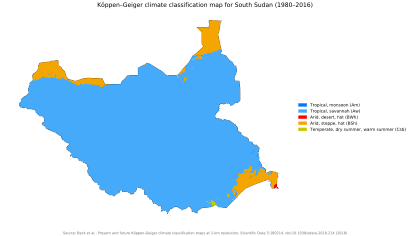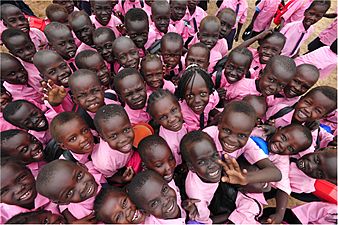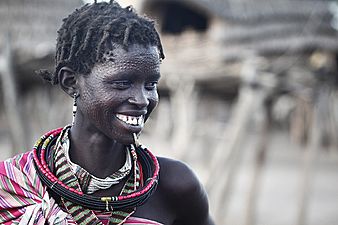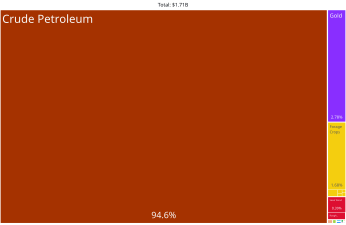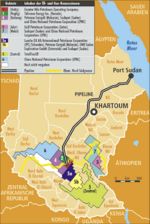South Sudan facts for kids
Quick facts for kids
Republic of South Sudan
|
|
|---|---|
|
|
|
|
Motto: "Justice, Liberty, Prosperity"
|
|
|
Anthem: "South Sudan Oyee!"
|
|
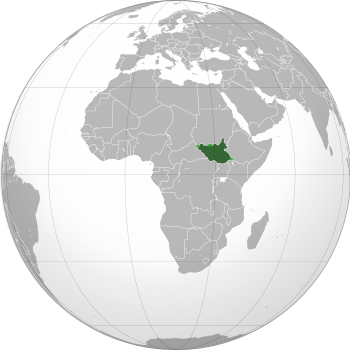
South Sudan in dark green, territory claimed but not fully controlled in light green
|
|
| Capital and largest city
|
Juba 04°51′N 31°36′E / 4.850°N 31.600°E |
| Official languages | English |
| Recognised national languages |
|
| Spoken languages |
|
| Religion
(2020)
|
|
| Demonym(s) | South Sudanese |
| Government | Federal presidential republic under a provisional government |
| Salva Kiir Mayardit | |
| Riek Machar | |
|
• Speaker
|
Jemma Nunu Kumba |
| Legislature | Transitional National Legislature |
| Transitional Council of States | |
| Reconstituted Transitional National Legislative Assembly | |
| Independence
from Sudan
|
|
|
• Autonomy
|
9 July 2005 |
|
• Declared and recognized
|
9 July 2011 |
| Area | |
|
• Total
|
619,745 km2 (239,285 sq mi) (41st) |
| Population | |
|
• 2024 estimate
|
12,703,714 (80th) |
|
• Density
|
13.33/km2 (34.5/sq mi) (214th) |
| GDP (PPP) | 2022 estimate |
|
• Total
|
|
|
• Per capita
|
|
| GDP (nominal) | 2022 estimate |
|
• Total
|
|
|
• Per capita
|
|
| Gini (2016) | ▼ 44.1 medium |
| HDI (2022) | low · 192nd |
| Currency | South Sudanese pound (SSP) |
| Time zone | UTC+2 (Central Africa Time) |
| Driving side | right |
| Calling code | +211 |
| ISO 3166 code | SS |
| Internet TLD | .ssa |
|
|
South Sudan, officially the Republic of South Sudan, is a country in East Africa. It is a landlocked nation, meaning it has no coastlines. It shares borders with Ethiopia, Sudan, the Central African Republic, the Democratic Republic of the Congo, Uganda, and Kenya. In 2023, its population was about 11 million people. Juba is both the capital and the largest city.
South Sudan became an independent country on July 9, 2011. This makes it one of the newest countries in the world. A large swampy area called the Sudd is found here. It is formed by the White Nile river. Before independence, the region was part of Sudan. It gained some self-rule in 1972. After a long civil war, a peace agreement was signed in 2005. In 2011, people voted, and 98.8% chose to become independent.
After gaining independence, South Sudan faced a civil war from 2013 to 2020. This conflict caused many people to leave their homes. The country is now working to recover from the war. It is led by a government formed by different groups.
South Sudan is one of the least developed countries in the world. It ranks very low in the Human Development Index. It is also one of the poorest countries based on its GDP per person. Most of its people belong to Nilotic peoples. It is a very young country, with about half of its population under 18 years old. Most people follow Christianity or traditional faiths. South Sudan is a member of the United Nations and the African Union.
Contents
What's in a Name?
The name Sudan comes from an Arabic phrase. It is bilād as-sūdān, which means "Land of the Blacks".
Exploring South Sudan's Geography
South Sudan is located in central Africa. It has tropical forests, large swamps, and wide grasslands. The famous White Nile river flows through the country, passing by the capital city, Juba.
Amazing Wildlife and Natural Areas
South Sudan is home to many incredible animals. Bandingilo National Park has the second-largest wildlife migration in the world. Boma National Park, the Sudd wetland, and Southern National Park are also important. These areas are home to many animals. You can find hartebeest, kob, topi, buffalo, elephants, giraffes, and lions.
The country's forests also have unique animals. These include the bongo, giant forest hogs, and chimpanzees. You can also spot different kinds of monkeys.
The land itself has many types of habitats. There are grasslands, high mountains, and wooded areas. There are also floodplains and wetlands. Special animals like the white-eared kob and Nile Lechwe live here. Other animals include common eland, giant eland, oryx, and African wild dogs.
South Sudan's Climate
South Sudan has a tropical climate. This means it is usually warm all year round. It has two main seasons. There is a rainy season with lots of humidity and rain. This is followed by a drier season.
Temperatures are always high. July is the coolest month, with temperatures between 68 and 86 degrees Fahrenheit (20 and 30 degrees Celsius). March is the warmest, with temperatures from 73 to 98 degrees Fahrenheit (23 to 37 degrees Celsius). Most rain falls between May and October. Sometimes, the rainy season can start in April and last until November. May usually gets the most rain.
People and Culture of South Sudan
South Sudan has a population of about 11 million people. Most people live in small villages. Sadly, wars have greatly affected the region. Millions of people have had to leave their homes. They became internally displaced persons or refugees.
Diverse Ethnic Groups
South Sudan is home to many different ethnic groups. The largest groups are the Dinka, the Nuer, the Bari, and the Azande. The Shilluk have a long history along the White Nile. Their language is similar to Dinka and Nuer. Many people from other African countries also live in South Sudan.
Education System
Children in South Sudan go to primary school for eight years. After that, they attend secondary school for four years. Then, they can go to university for another four years.
English is the main language used for teaching in schools. This is different from the Republic of Sudan, where Arabic is used. In 2007, English became the official language for communication in South Sudan. There is a need for more English teachers, especially for science and technical subjects.
In 2019, the first public library opened in Juba. It is called the Juba Public Peace Library. It has over 13,000 books and many volunteers.
Languages Spoken in South Sudan
The official language of South Sudan is English. However, there are over 60 different indigenous languages spoken. These are all considered national languages. Some of the most common ones include Dinka, Nuer, Murle, Luo, Ma'di, Otuho, and Zande.
There are plans to make Swahili a second official language. It is now being taught in schools. This will help South Sudan connect better with its East African neighbors. Most of the local languages belong to the Nilo-Saharan Language family.
South Sudanese Culture and Arts
Years of civil war have shaped South Sudan's culture. Many South Sudanese people fled to nearby countries like Ethiopia, Kenya, and Uganda. There, they learned new languages and cultures. Those who stayed in Sudan often learned Juba Arabic or Sudanese Arabic.
Most South Sudanese people value their tribal origins. They want to keep their traditional culture and dialect alive, even if they live far from home. While English and Juba Arabic are common, learning Swahili could help the country build stronger ties with its neighbors.
Music Scene
South Sudanese musicians often sing in English, Swahili, Juba Arabic, or their local African languages. Sometimes they mix them all! Popular artists like Barbz and Yaba Angelosi sing Afro-beat, R&B, and Zouk. Dynamq is known for his reggae music. Emmanuel Kembe sings folk, reggae, and Afro-beat.
There are also hip hop artists like Emmanuel Jal. Emmanuel Jal is a former child soldier who became a musician. He is known internationally for his unique hip hop style and positive messages. He has performed at big events like TED.
Games and Sports
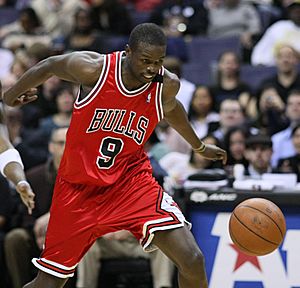
Many traditional and modern games are popular in South Sudan. Wrestling and mock battles are especially liked. Traditional sports were often played after harvest time. This was a way to celebrate and mark the end of the farming season. Wrestlers would put ochre on their bodies. This might have helped them grip or made them feel stronger. Many people would watch, singing, drumming, and dancing to support their favorite wrestlers. These events were mostly for fun and entertainment.
Association football (soccer) is also becoming very popular. The government and other groups are working to promote the sport. They want to improve the level of play. The South Sudan Youth Sports Association (SSYSA) holds football clinics for young boys. South Sudan has even hosted youth football competitions.
The South Sudan national football team joined the Confederation of African Football in 2012 and FIFA in May 2012. Their first game was in July 2011. Famous South Sudanese footballers include James Moga and Richard Justin.
South Sudan has produced many talented basketball players. Luol Deng was a star in the National Basketball Association (NBA) in the United States. He also played for Great Britain. Other top players from South Sudan include Manute Bol, Wenyen Gabriel, and Thon Maker. The South Sudan national basketball team played its first game in July 2011.
One athlete, Guor Marial, competed in the 2012 Summer Olympics. Since South Sudan did not yet have an Olympic organization, he competed as an Independent Olympic Athlete. In 2015, South Sudan's National Olympic Committee was fully recognized. South Sudan then competed in the 2016 Summer Olympics with three athletes.
South Sudan's Economy
South Sudan's economy is one of the least developed in the world. It has very little existing infrastructure. In 2011, it had the highest rates of mothers dying during childbirth and women who could not read.
South Sudan sells timber to other countries. The country also has many natural resources. These include petroleum (oil), iron ore, copper, zinc, gold, and diamonds. It also has valuable hardwoods and limestone. The country's economy relies heavily on agriculture.
Besides natural resource companies, other businesses operate here. One example is Southern Sudan Beverages Limited, which is part of SABMiller.
Oil Resources
South Sudan has the third-largest oil reserves in Sub-Saharan Africa.
China National Petroleum Corporation (CNPC) is a big investor in South Sudan's oil industry. However, the country needs to find other ways to make money. Experts believe that oil reserves might be cut in half by 2020 if no new oil is found.
Images for kids
-
Rural school children participating in a USAID-funded radio learning project, July 2010
-
A tribeswoman with traditional scarification in South Sudan, 2011
-
Loka Teaks is the largest teak plantation in Africa.
See Also
 In Spanish: Sudán del Sur para niños
In Spanish: Sudán del Sur para niños





